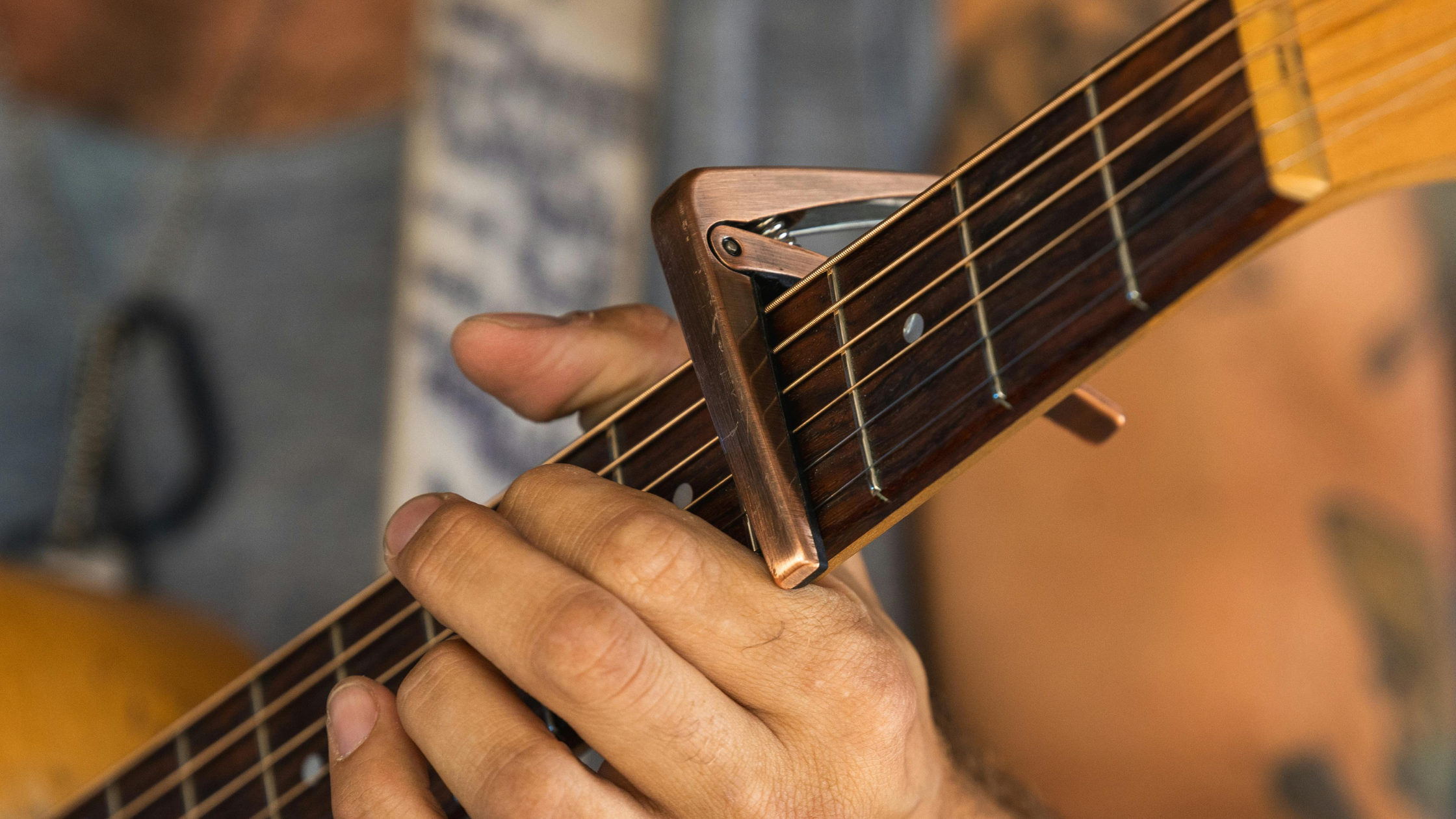A guitar capo is an essential tool that can unlock new possibilities for your playing.
By clamping onto the neck of the guitar, a capo changes the pitch of the strings, allowing you to play in different keys without changing your chord shapes.
This handy accessory is especially popular among singer-songwriters who want to match their vocal range with their guitar accompaniment, as well as performers looking to add variety to their set.
Capos come in many shapes and sizes, including trigger capos, C-clamp capos, and partial capos.
Each type offers its own set of advantages, depending on your playing style and requirements.
Trigger capos are quick to move, C-clamp capos offer more precise tension control, and partial capos enable creative tuning possibilities by leaving some strings open.
Choosing the right capo can significantly enhance your playability and creativity.
When selecting a capo, consider factors like material, ease of use, and compatibility with your instrument.
Materials like stainless steel and aircraft-grade aluminum provide durability, while rubber padding is crucial to protecting your guitar neck.
A good capo should clamp securely without buzzing and be easy to move with one hand.
We researched and tested a range of capos to find those that combine performance, durability, and ease of use, making your playing experience effortless.
Best Guitar Capos
Explore our selection of top guitar capos to enhance your playing experience.
This list covers options that provide reliability and superior performance for musicians of all styles.
Whether you’re a beginner or a seasoned player, you’ll find a capo that fits your needs perfectly.
Kyser Quick-Change Capo

This capo combines ease of use with solid construction, making it a reliable addition to any guitarist’s toolkit.
Pros
- Operates smoothly with one hand
- Durable aluminum construction
- Stores conveniently on a headstock
Cons
- High tension might be excessive for some users
- Limited to six-string guitars
- Price is higher than some alternatives
Crafted from lightweight yet sturdy aluminum, the Kyser Quick-Change Capo impresses with its robust build.
The steel spring ensures consistent pressure across the fretboard, resulting in clear sound each time you use it.
Whether you’re switching between frets or storing it on the headstock during breaks, the capo remains secure without hindering your play.
One-handed operation is remarkably smooth, especially when you’re in the middle of a set and need quick key changes.
The convenience of parking it on the guitar when not in use can’t be overstated.
This feature helps you avoid misplacing your capo, which is common with other models.
If aesthetics matter, the clean black finish gives it a sleek appearance.
Some may find the high tension a bit too firm, potentially affecting the feel while playing.
While it’s designed for six-string guitars, it won’t fit other types, which could be limiting if you have a diverse collection.
Despite its somewhat higher price point, the life guarantee and build quality provide good value for serious players searching for reliability in every performance.
WINGO Guitar Capo – Rosewood Color

This capo is a reliable choice for any guitarist seeking both aesthetic appeal and functionality at a reasonable price.
Pros
- Simple and quick to adjust on your guitar.
- Offers a nice, attractive wood finish.
- Strong spring provides a clear tone.
Cons
- Included picks may not suit all preferences.
- Limited width may not fit some guitar necks.
- Might struggle with certain string gauges.
Changing keys on the fly couldn’t be easier with the WINGO capo. Its quick-release design lets you effortlessly reposition it as needed, which is invaluable during live performances or practice sessions.
The eye-catching rosewood finish is a pleasant departure from typical capos, adding a touch of style to your setup.
You’ll appreciate the consistent pressure it applies, ensuring every note rings clear without any dreaded fret buzz.
Its compatibility with various instruments, such as electric and steel-string acoustic guitars, enhances its versatility.
You’re not confined to just one type of guitar, making it a great addition to any playstyle.
Still, the capo may not handle wider necks, particularly on classical guitars.
While the included picks can be handy spares, they might not fit all playing styles, making them an optional benefit.
Nonetheless, every strum with this capo will convince you of its potential to improve your music experience.
D’Addario NS Tri-Action Capo

A dependable choice for clear, buzz-free performance, offering ease and durability.
Pros
- Adaptable tension control for precise sound
- Lightweight yet sturdy construction
- Handy built-in pick holder
Cons
- Limited to black color
- It might feel large on smaller necks
- May require regular adjustment
Experience seamless transitions across frets with the D’Addario NS Tri-Action Capo.
This capo handles effortlessly with its Tri-Action Geometry, adjusting with ease while staying perfectly in tune.
Its solid aluminum build feels robust in hand without adding unnecessary heft.
It’s designed to deliver consistent pressure across all strings, minimizing the need for retuning.
The micrometer tension adjustment is particularly useful, allowing you to fine-tune the grip for your specific guitar neck, resulting in a precise, buzz-free performance.
Beyond performance, the capo’s single-handed operation is convenient and practical.
An integrated pick holder keeps your pick within easy reach, adding a touch of thoughtful design.
Whether you’re strumming in your living room or performing on stage, this capo stands up to the task with dependable functionality.
Buying Guide
Choosing the right guitar capo requires considering various features to ensure it suits your needs.
First, consider the material. Capos come in materials like plastic, metal, and silicone.
Metal is durable and often preferred for its robust feel, whereas plastic is lighter but may wear out quicker.
Design matters too. Trigger-style capos are popular for their ease of use, allowing quick one-hand adjustments. For precision, look into screw-type capos which offer more control on pressure applied to the strings.
Key Considerations
- Compatibility: Make sure the capo fits your guitar’s neck. Different guitars (acoustic, electric, classical) have varying neck shapes.
- Pressure: Check that the capo provides adequate tension without causing string buzz or altering tuning.
- Weight: A lightweight capo reduces additional weight on your neck, potentially better for prolonged use.
- Ease of Use: Look for capos with quick-release mechanisms for easy repositioning.
Materials and Build
| Material | Pros | Cons |
|---|---|---|
| Metal | Durable, robust feel | Heavier |
| Plastic | Lightweight, affordable | Less durable |
| Silicone | Soft, protects strings | May wear over time |
Additional Features
- Rubber Padding: Ensures strings are cushioned and protected.
- Aesthetic: Choose a capo that complements the look of your guitar.
- Adjustability: Some capos offer adjustable tension, providing versatility across different string gauges.
When selecting a capo, balance your needs with your budget, ensuring you get a reliable tool that enhances your guitar playing experience.
Frequently Asked Questions
Many guitarists are on the lookout for the perfect capo. Your choice will depend on your guitar type, playing style, and personal preferences.
What are the top rated capos for acoustic guitars?
Several options stand out for acoustic guitars, including the Kyser Quick-Change, Shubb Deluxe, and G7th Performance 3.
These models are popular for their durability, ease of use, and reliable pressure distribution.
Which capo is best suited for classical guitar players?
Classical guitarists often prefer capos like the Shubb C2 or the G7th UltraLight.
These are designed to accommodate the wider neck and nylon strings typical of classical guitars, ensuring even pressure without fret buzz.
How do professional guitarists typically use capos?
Professionals use capos to change the key of a song effortlessly or to explore alternative chord voicings.
This allows for more creative flexibility during performances and recordings.
Is there a difference in capo performance in relation to their material composition?
Capos made from durable materials like stainless steel or aircraft-grade aluminum often provide better longevity and maintain consistent pressure over time.
Plastic capos may offer lightweight convenience but might wear out more quickly.
What criteria should beginners consider when choosing their first guitar capo?
Beginners should consider ease of use, compatibility with their guitar type, and cost.
A lightweight capo with a simple clamping mechanism is often the best starting point, ensuring smooth operation without any setup challenges.
What are the advantages of investing in a high-end guitar capo?
High-end capos often deliver superior build quality, longevity, and precise pressure control, reducing string buzz.
They can enhance overall performance quality and provide an improved playing experience.





